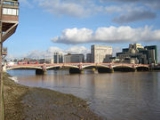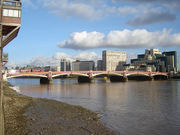
Alexander Binnie
Encyclopedia
Sir Alexander Richardson Binnie (1839–1917) was a civil engineer
responsible for several major engineering projects, including several associated with crossings of the River Thames in London
.
 As chief engineer for the London County Council
As chief engineer for the London County Council
, his design feats included the first Blackwall Tunnel
(1897) and Greenwich foot tunnel
(1902) (both in Greenwich, London) and, further upstream, Vauxhall Bridge
(1906).
By then knighted by Queen Victoria
for services to engineering, he was elected President of the Institution of Civil Engineers
in 1905.
He also designed, with Sir Benjamin Baker, major parts of London's drainage system, including east London sewage treatment works at Crossness
and Barking
on the south and north sides of the Thames respectively (these were sited at the ends of the sewer outfalls created by Sir Joseph Bazalgette
during the late 19th century). Further afield, he also designed water works in Bradford
, West Yorkshire
.
Like several other notable engineers of the late 19th and early 20th centuries (e.g.: Sir William Halcrow
, Sir Alexander Gibb
), Binnie founded a firm under his name, which his son William
took over on his father's retirement. in 1909 Sir Alexander Binnie and Son merged with another engineering consultancy to become Sir Alexander Binnie, Son & Deacon
; later it became Binnie & Partners and from the 1990s it has been part of the multi-national Black & Veatch
consultancy.
Civil engineer
A civil engineer is a person who practices civil engineering; the application of planning, designing, constructing, maintaining, and operating infrastructures while protecting the public and environmental health, as well as improving existing infrastructures that have been neglected.Originally, a...
responsible for several major engineering projects, including several associated with crossings of the River Thames in London
London
London is the capital city of :England and the :United Kingdom, the largest metropolitan area in the United Kingdom, and the largest urban zone in the European Union by most measures. Located on the River Thames, London has been a major settlement for two millennia, its history going back to its...
.

London County Council
London County Council was the principal local government body for the County of London, throughout its 1889–1965 existence, and the first London-wide general municipal authority to be directly elected. It covered the area today known as Inner London and was replaced by the Greater London Council...
, his design feats included the first Blackwall Tunnel
Blackwall Tunnel
The Blackwall Tunnel is a pair of road tunnels underneath the River Thames in east London, linking the London Borough of Tower Hamlets with the London Borough of Greenwich, and part of the A102 road. The northern portal lies just south of the East India Dock Road in Blackwall; the southern...
(1897) and Greenwich foot tunnel
Greenwich foot tunnel
The Greenwich foot tunnel is a pedestrian tunnel crossing beneath the River Thames in East London, linking Greenwich in the south with the Isle of Dogs to the north...
(1902) (both in Greenwich, London) and, further upstream, Vauxhall Bridge
Vauxhall Bridge
Vauxhall Bridge is a Grade II* listed steel and granite deck arch bridge in central London. It crosses the River Thames in a south–east north–west direction between Vauxhall on the south bank and Pimlico on the north bank...
(1906).
By then knighted by Queen Victoria
Victoria of the United Kingdom
Victoria was the monarch of the United Kingdom of Great Britain and Ireland from 20 June 1837 until her death. From 1 May 1876, she used the additional title of Empress of India....
for services to engineering, he was elected President of the Institution of Civil Engineers
Institution of Civil Engineers
Founded on 2 January 1818, the Institution of Civil Engineers is an independent professional association, based in central London, representing civil engineering. Like its early membership, the majority of its current members are British engineers, but it also has members in more than 150...
in 1905.
He also designed, with Sir Benjamin Baker, major parts of London's drainage system, including east London sewage treatment works at Crossness
Crossness
Crossness is a place in south-east London. It is situated in the London Borough of Bexley, close to the southern bank of the River Thames, to the east of Thamesmead, west of Belvedere and north-west of Erith. The place takes its name from Cross Ness, a specific promontory on the southern bank of...
and Barking
Barking
Barking is a suburban town in the London Borough of Barking and Dagenham, in East London, England. A retail and commercial centre situated in the west of the borough, it lies east of Charing Cross. Barking was in the historic county of Essex until it was absorbed by Greater London. The area is...
on the south and north sides of the Thames respectively (these were sited at the ends of the sewer outfalls created by Sir Joseph Bazalgette
Joseph Bazalgette
Sir Joseph William Bazalgette, CB was an English civil engineer of the 19th century. As chief engineer of London's Metropolitan Board of Works his major achievement was the creation of a sewer network for central London which was instrumental in relieving the city from cholera epidemics, while...
during the late 19th century). Further afield, he also designed water works in Bradford
Bradford
Bradford lies at the heart of the City of Bradford, a metropolitan borough of West Yorkshire, in Northern England. It is situated in the foothills of the Pennines, west of Leeds, and northwest of Wakefield. Bradford became a municipal borough in 1847, and received its charter as a city in 1897...
, West Yorkshire
West Yorkshire
West Yorkshire is a metropolitan county within the Yorkshire and the Humber region of England with a population of 2.2 million. West Yorkshire came into existence as a metropolitan county in 1974 after the passage of the Local Government Act 1972....
.
Like several other notable engineers of the late 19th and early 20th centuries (e.g.: Sir William Halcrow
William Halcrow
Sir William Halcrow was one of the most notable English civil engineers of the 20th century, particularly renowned for his expertise in the design of tunnels and for projects during the Second World War.-Early years:...
, Sir Alexander Gibb
Alexander Gibb
Brigadier-General Sir Alexander Gibb GBE CB FRS was a Scottish civil engineer.Gibb was born in Broughty Ferry, Dundee, the son of the civil engineer, Alexander Easton Gibb, and the grandson of John Gibb, a founder member of the Institution of Civil Engineers...
), Binnie founded a firm under his name, which his son William
William Binnie (engineer)
William James Eames Binnie was a British civil engineer. William was the son of Alexander Binnie the famed civil engineer and William would enter the same career. He was educated at Trinity College, Cambridge before completing an apprenticeship with his father's firm...
took over on his father's retirement. in 1909 Sir Alexander Binnie and Son merged with another engineering consultancy to become Sir Alexander Binnie, Son & Deacon
George Deacon (civil engineer)
George Frederick Deacon was an English Civil Engineer. He was a pupil and lifelong friend of William Thomson, 1st Baron Kelvin. He was Lord Kelvin's assistant on the SS Great Eastern cable-laying expedition. He was both borough engineer and water engineer to Liverpool from 1871 to 1880, and water...
; later it became Binnie & Partners and from the 1990s it has been part of the multi-national Black & Veatch
Black & Veatch Corporation
Black & Veatch is a global engineering, consulting, construction and operations company specializing in infrastructure development in energy, water, telecommunications, management consulting, federal and environmental markets. Black & Veatch is the 11th largest majority Employee-Owned company in...
consultancy.

